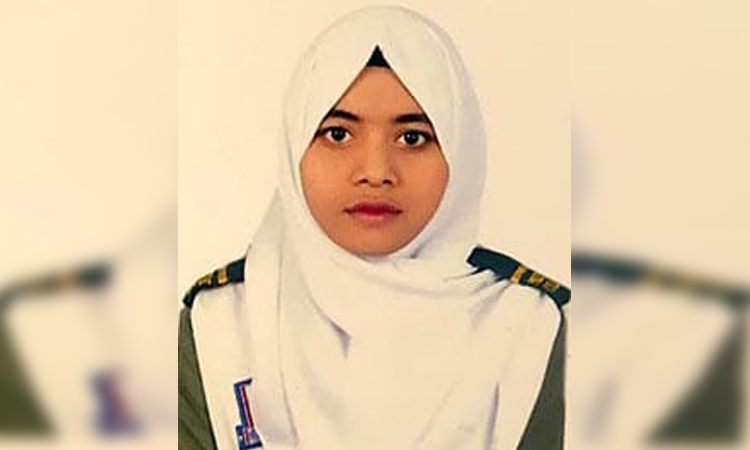News Flash

By Ismail Ahsan
DHAKA, May 30, 2025 (BSS) - Naima Sultana, a 15-year-old schoolgirl from Uttara, who dreamt to be a doctor, was shot dead during the July uprising, 2024.
A science student of class ten at Milestone School and College, Naima had aspired to become a doctor. But that dream, nurtured by her struggling but determined parents, was silenced by bullets allegedly fired by police and armed leaders and activists of Awami League.
Naima’s untimely death on July 19 last year marked a tragic turning point in the nationwide anti-discrimination protests, intensifying outrage and grief across the country.
“She was trying to peek from our balcony to see what was happening down the street when she was hit in the head. She collapsed right there, on the spot,” said her mother, Aynun Nahar, barely able to speak between sobs, told BSS.
“For the past two and a half months, I haven’t been able to cook anything properly. Every time I try, her memory haunts me.”
The July movement took a violent turn after the killing of Abu Sayed, a young protester in Rangpur on July 16. Mass outrage followed, and by July 18, large-scale police crackdowns in areas like Uttara resulted in dozens of civilian deaths.
According to residents and activists, at least 30 people were shot dead in Uttara alone on that day, with many bodies reportedly concealed by police forces.
On the following day on July 19, grief turned into resistance as a massive student protest erupted in Uttara. This time, students were joined by their parents, many of whom demanded to know why their children had been targeted.
Witnesses described a charged atmosphere of mourning and fury as thousands took to the streets, chanting slogans and demanding justice.
Naima Sultana lived with her family in a modest rented apartment on the main road behind Bangladesh Medical College in Uttara’s Sector 9. The second of three children of Golam Mostafa, a village pharmacist, and Ainun Nahar, she was known as the brightest among her siblings.
Her room, like the family’s small drawing space, still holds neatly arranged science textbooks and guidebooks, silent witnesses to a life full of promise. Every corner of the home carries her presence. All of it remains untouched, except for one unbearable absence: Shaheed Naima Sultana is no longer there.
Talking to BSS, Senior journalist Abdullah Al Mahmud, who resides in the same building as Naima’s family, described the sequence of events. “That day, clashes began around noon. Students were being chased by both police and Awami League leaders and activists.”
“Naima and several others moved closer to their building for shelter. The police took up a position in the alley just 200 yards away from their house. Naima had gone up to her balcony, perhaps to check if it was safe. Then, shots were fired. I saw her fall with my own eyes,” Mahmud said.
He later carried her lifeless body to the hospital, risking his own safety in the process. “There was so much blood… we were just ordinary people trying to save a child. It felt like a war zone.”
Inside their modest apartment behind Bangladesh Medical College in Sector 9 of Uttara, remnants of Naima’s life remain untouched—her neatly arranged science textbooks, the posters she painted for protests, and her drawings still hanging on the walls.
“She wasn’t just vocal; she inspired others,” her mother said. “She would draw protest art and encourage her friends to join rallies. Her graffiti is still on the walls of Uttara.”
Born in Amuakandi village in Matlab Uttar, Chandpur, Naima excelled academically from an early age. She was the second of three siblings and consistently topped her classes.
The family had moved to Dhaka to ensure better educational opportunities for the children, while her father, Golam Mostafa, continued running a small pharmacy in the village to support them.
“She used to say, ‘Ma, let me go to the rally. I must go. You can’t stop me.’ And she didn’t just go—she took her friends with her. That’s how committed she was,” said her mother.
Her elder sister, Taspia Sultana, also a science student at Milestone College, recalled their close bond. “We did everything together. We walked to school, studied, and joked. Now, I feel like I have lost not just my sister but a part of myself.”
Their youngest sibling, Abdur Rahman, a Class II student at the same school, has been traumatized into silence since witnessing his sister’s death. “He just stares blankly. He doesn’t talk,” their mother said.
The family, overwhelmed with grief and isolation, has not pursued any legal action. “We have no one in Dhaka to help us file a case. Who would run it? We’ve handed it over to Allah,” said Naima’s mother.
“Her father has grown more ill after the incident. He can’t stay in Dhaka anymore. He breaks down every time he sees her drawings or books.”
In honor of her sacrifice, local students and residents unofficially renamed a prominent spot at the western edge of Sonargaon Janapath—road near the canal as ‘Naima Chattar’.
Her protest art remains visible on the area’s walls, now acting as silent reminders of both resistance and loss.
“She was a symbol,” said one of her classmates. “Her death can’t go in vain. Justice must be served for her and for the countless others who died for equality and dignity.”